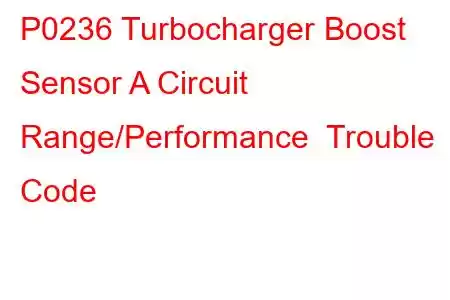P0236 Turbocharger Boost Sensor A Range/Performance
OBD-II Trouble Code Technical Description
Generic: Turbocharger Boost Sensor A Range/Performance
GM: Turbocharger Boost System Performance
Dodge Diesel Pickups: MAP Sensor Too High Too Long
What does that mean?
This DTC is a generic powertrain code that applies to all turbocharged vehicles. The differences in the above listed descriptions are due to the method by which the pressure in the intake manifold is measured.
The power train control module (PCM) both controls and monitors boost pressure, and if measured pressure is greater than commanded pressure, the DTC P0236 will be set and the PCM will turn on the check engine light. In order to diagnose this code, you must have a general understanding of three things:
What is boost pressure? How is it controlled? How is it measured?In a normally aspirated engine (i.e. non-turbo) the downward motion of the pistons, called the intake stroke, creates vacuum in the intake manifold in the same way a syringe draws in fluid. This vacuum is how the air/fuel mixture is drawn into the combustion chamber. A turbocharger is a pump driven by exhaust gasses as they exit the combustion chamber. This creates pressure in the intake manifold. So instead of the engine having to “suck” the air/fuel mixture in, it instead is force fed a greater volume. In essence, there is already compression before the piston begins its compression stroke, as a result increasing compression and therefore increasing power. This is boost pressure.
Boost pressure is controlled by the amount of exhaust gases allowed to pass through the turbo. The greater the amount, the faster the turbo spins, the greater the boost pressure. Exhaust gas is routed around the turbo through a bypass that is known as the waste gate. The PCM controls boost pressure by regulating the opening of the bypass. It does this by opening or closing the waste gate as needed. This is accomplished by means of a vacuum motor mounted on, or near the turbo. The PCM controls the amount of vacuum going to the vacuum motor via a control solenoid.
The actual pressure in the intake manifold is measured by either a boost pressure sensor (Ford/VW) or a manifold absolute pressure sensor (Chrysler/GM). The different sensor types account for the different technical description given by each manufacturer but both perform the same function.
This particular code is one that should be addressed as soon as possible due to the increased risk of over boost and catalytic converter damage.
Symptoms
When conditions to set P0236 are present the PCM ignores actual manifold pressure readings and uses a inferred or assumed manifold pressure, limits the amount of fuel and dynamic injection timing allowed. The PCM enters what is called failure mode engine management (FMEM) and is most noticeable by a lack of power.
Causes
Potential causes for this code to set are:
Vacuum supply Pinched, collapsed or broken vacuum lines Faulty control solenoid Faulty PCMDiagnostic and Repair Procedures
A good starting point is always to check for technical service bulletins (TSB) for your particular vehicle. Your issue may be a known issue with a known fix put out by the manufacturer and can save you time and money during diagnosis.
Visually inspect for kinked, pinched, cracked or broken vacuum lines. Check all of the lines not just the ones related to waste gate control. A significant leak anywhere in the vacuum system can cause poor performance of the entire system. If okay move on to step 2. Using a vacuum gauge check for vacuum at the input side of the control solenoid. If none is present suspect a faulty vacuum pump. If vacuum is present move on to step 3. The control solenoid is operated by Pulse width modulation or duty cycle. Using a digital volt ohm meter, that has a duty cycle or frequency setting, back probe the signal wire at the solenoid connector. Drive the vehicle and check to see that a signal shows on the DVOM. If signal is present suspect a faulty control solenoid. If no signal suspect a faulty PCMRead: 51


